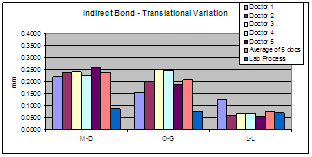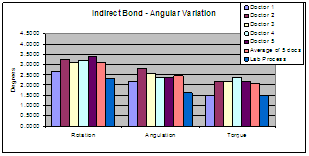ABSTRACT: 2394
Orthodontist's Bracket Placement Repeatability
| M.-L. LAI, 3M Unitek, Monrovia, CA, USA, and J.K. MAH, University of Southern California, Los Angels, California, USA | |||||
Orthodontist's Bracket Placement Repeatability Objective: Bracket placement accuracy is crucial for optimal orthodontic treatment results using the “straight wire” methodology. This paper describes the bracket placement repeatability in 6-degrees-of-freedom. Five orthodontists participated in the study. Method: One pair of upper and lower maloccluded arches were digitized and then 6 replica models were printed from an Results: Pooled standard deviations (PSTDEV) of the bracket placement repeatability were measured for each doctor and the lab process. Measurements of 3 translational (M-D=medial-distal, O-G=occlusal-gingival, L-L=labial-lingual) variations and 3 angular variations were taken (Figs. 1a-d).
(a) (b) (c) (d) Figs. 1a-d Bracket Placement Variations Conclusions: It may be concluded that when those orthodontists use their own direct and indirect bond techniques to place the bracket for each tooth, 95% (2 PSTDEV's) of the brackets may be repeatedly placed within ±0.5 mm and ±6.2 degrees versus the lab process of within ±0.2 mm and ±4.9 degrees respectively. | |||||
| Seq #224 - Orthodontic Tooth Movement and Materials 3:30 PM-4:45 PM, Friday, July 4, 2008 Metro Toronto Convention Centre Exhibit Hall D-E | |||||
|
Back to the Dental Materials 8: Other Materials - Chemistry, Properties and Performance Program | |||||
©Copyright 2008 American Association for Dental Research. All Rights Reserved.



